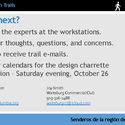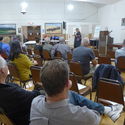Open house for the Touchet Valley Trail held in Dayton
Same information shared in Waitsburg
September 26, 2019

Tracy Thompson
Experts in Quality of Life, Safety and Transportation, and Operations and Maintenance were on hand to field questions from the attendees at open houses in Dayton and in Waitsburg for the Touchet Valley Trail.
DAYTON-Roughly ninety people attended the Touchet Valley Trail open house, at the fairgrounds Pavilion, in Dayton, on Monday, Sept. 16.
Joy Smith President of the Waitsburg Commercial Club spoke to the attendees about the importance of outdoor recreation and trails to the economic vitality, health, and safety, of the local communities.
Smith said she ran an overnight rental for seven years, in Waitsburg, and two thirds of the overnight guests came with bicycles. Also ten percent of renters were interested in equestrian facilities.
"Outdoor recreation is a 22 billion dollar business in the state of Washington," said Smith.
Smith said business owners attribute 25% of the revenue they receive to being proximal to recreation trails.
"If you remember nothing else tonight, for every dollar invested in tourism, ten dollars is reinvested in tax dollars," said Smith.

"In Waitsburg I always talk about our sports arena. Our sports arena is the Blue Mountains," Smith said. "We have a beautiful sports arena."
Smith said what is also known is that trails and outdoor recreation are a deciding factor for people looking for a place to live, and that trails and outdoor recreation offer families a great way to stay active.
"It's becoming a quality of life issue," she said.
She said the best thing for the community is to have some green space.
"I like spaces that rest the eye. I like to see us protect our open spaces. I don't want to become a Portland or Seattle corridor where we go from one suburb to another suburb to another suburb.

Trails are safe, she said.
She said crime along trails is not common. For instance, the Bill Chipman Trail, from Moscow to Pullman, receives little more than two calls for law enforcement each year, and there are no property incidences because of the trail.
Smith said, "When you open up spaces, invite people in, and shine a light on spaces, security is better. People know each other. They start to recognize people on the trail."
The Walla Walla and Columbia County Sheriff's Offices know they have the capacity to respond to any incident on the trail," she said.
Smith said trails offer a safer route for bicycles.
"You all know what it's like when you come across a bicyclist on Hwy. 12, or Hwy. 124 or Lower Waitsburg Road, or Middle Waitsburg Road. My heart is always in my throat because I know there is always a possibility they could fall in front of you. We want them to be on a safe path," she said.
Andrea Weckmueller-Behringer, Executive Director of the Walla Walla Valley Metropolitan Planning Organization, spoke to the history of the Blue Mountain Regional Trails project, which began with a 2015 Walla Walla Community Council study on Enhancing Outdoor Recreation.
She said the Blue Mountain Regional Trails project connecting Dayton to Umatilla County was a result of that study.
She said it has taken the effort of thirty multijurisdictional stake holders, with the Community Council serving as the lead agency, and with technical expertise from the National Park Service to plan the series of connecting trails.
"It was a very focused effort, and everybody really wanted this to succeed. It was a great group to work with," she said.

Weckmeuller-Behringer said the BMRT planning committee was notified of the National Park Service grant for technical expertise, in Oct. 2016, and multiple rounds of public outreach took place, beginning in November, 2016. The Plan was adopted before the March, 2018, goal, she said.
"We wanted to make sure that this was a community supported effort. So from the very get-go we knew that we were going to go out to the public at key decision points to make sure that we heard from everybody," Weckmueller-Behringer said.
She said the same workshops were held in multiple locations throughout the region.
During the first round of workshops people were asked to identify what connections they would like to have.

"We gathered 1,000 different ideas, and they were digitized," she said.
A second round of public outreach took place to help prioritize the connections.
"We talked to everybody who wanted to talk to us," she said.
She said conceptual networks were created using that data and public feedback.
Weckmeuller-Behringer said the planning committee asked for specific comments from the public during a third round of workshops.
"We did make a couple of tweaks based on public feedback, just, simply, because we had that information directly from you," she said.
The entire process was inclusive, with materials provided in Spanish, she said.
"There were no hidden agendas," said Weckmeuller-Behringer. "This inclusive outreach is what drove the process forward."

"This was the first project, ever, where we had gotten a call from a grant funding agency. They said we heard about your project. We have money for this kind of thing, so please hurry up and finish the Plan," Weckmeuller-Behringer said.
She said the Touchet Valley Trail, from Dayton to Waitsburg, is the first project to move forward to implementation.
Port of Columbia Executive Director Jennie Dickinson said she first heard about the importance of trails and paths at a Columbia Cares meeting, back in the early 2000s.
At the annual Comprehensive Economic Development Strategy meeting in Dec. 2015, attendees voted for their top three wishes for Columbia County and having a bike trail connecting Dayton to Waitsburg came in at Number Two. In 2016, it moved into first place, she said.
"I was quite surprised because it always was about jobs," she said. "For many of the people in the community, things had improved here, and they weren't thinking as desperately about jobs, as they had in the past. Quality of life issues were rising more to the top."
Dickinson said Ports across the state have trails, parks and marinas. The Port of Columbia has been responsible for the Lyons Ferry Marina since the early 1970s.
"Our tourism authority was expanded in 1984," she said.
The trail meets the Port's mission. It is included in the Comprehensive Plan. It is in the Cooperative Parks Master Plan, for the city, the county, and the Port, she said.
"It wasn't just some wild idea the Port commissioners thought up. This was very much a long term plan."

Dickinson said the Port participated in the Blue Mountain Regional Trails project from the beginning and the Touchet Valley Trail was identified for first implementation.
The National Park Service suggested establishing a steering committee, which has been accomplished.
Dickinson said they have received an award from the state Department of Transportation for bicycle and pedestrian safety, which can only be used for bicycle and pedestrian projects.
"If we were to turn it away it would go to a different community," she said.
Cost estimates for the trail range from 3.5 to 6 million dollars, Dickinson said.
"We really won't know how much it is going to cost until the design is done," she said. "It may have to be built in phases."
She said representatives from WADOT have looked at the site and have determined the need for some new bridges over the Touchet River.
The Port is required to provide a $20,000 match, she said.
She said Port funds come from property tax and from leased revenue. The Port receives over $300,000 a year from leased revenue, from private businesses.
Since the Port-owned property along the rail lines has been identified as the best place for the trail there will be an extensive title search made, she added.
"We're working on public outreach right now," Dickinson said.
There was a listening session conducted in June for landowners with property adjacent to the rail lines, and an online public survey was conducted, as well.
The Port's Economic Development Coordinator Kathryn Witherington talked about the survey mentioned by Dickinson.
"We heard back from a lot of you in this room. It was a great way to gather good feedback."
She said the bulk of respondents were from the local communities, and the majority of them want walking and biking trail with river access, preferably paved, or dual surface paved. They also want pet waste bags.
"All are elements that can be used to inform the design," she said.
She said the majority of people are pretty excited about the trail, but some have reservations.
"A lot of those people have come and talked to us, about their reservations and realized they can be addressed through design," she said. "And there are people opposed. We know that, and we want to talk to those people, and find out why they are opposed, and see how we can make them more comfortable, because, ultimately, we want this to be a trail that is embraced by the entire community," she said.
Witherington pointed to a six page list of Frequently Asked Questions saying it grew over the course of the past summer.
"You have the very detailed answers in that document. It is a living document. It is going to keep growing, because we don't know everything yet," she said.
For instance, part of the design process is to determine whether the trail will be located on the north or on the south side of the rail lines, said Witherington.
While there is much that is not yet known, Witherington said there is much that is known.
For instance, Walla Walla and Columbia Counties are Right to Farm Counties and they can't be told not to apply agricultural spray to their crops. She also said the National Park Service has advised closing the trails during harvest, for safety reasons.
As far as liability goes, Witherington said, "Check with your own insurance agency. One landowner said her agent said the liability doesn't change."
Construction funds can't come from local taxes said Witherington.
"The state has that money in the Puget Sound area. We can get some of it," she said.
"We can't promise in the long term local dollars won't be used to maintain it," she said. But if we do, it will be something that comes out of existing dollars. If at some point in the future we want to increase taxes in order to maintain this trail, we as a community will have to vote on it.
Witherington said she spends a lot of time thinking about the feedback from the community, both the good and the bad, and how to get people to embrace the trail.
"I want it to be a trail people connect with, love, and embrace moving forward," she said.
Dckinson said the Touchet Valley Trail project is currently in the conceptual planning phase.
The National Park Service has created a partnership between the American Society of Landscape Architects and students taking a WSU Landscape Architecture class. The instructor of the class has helped with the Bill Chipman Trail, between Pullman and Moscow, and is currently helping with a trail project between Colfax, Albion and Pullman.
Members of the professional architect group and the WSU students will meet in Dayton on Oct. 25, after which two professional architects will team up with two or three local people, for a "very intensive design workshop".
All public comments from that workshop will be incorporated into the concept design, to try to mitigate any concerns people have. Then the concept plan will be shared with the public on Oct. 26. Public feedback will be taken into consideration for creation of the final concept plan, which should be in place by the end of the year, Dickinson said.






Reader Comments(0)